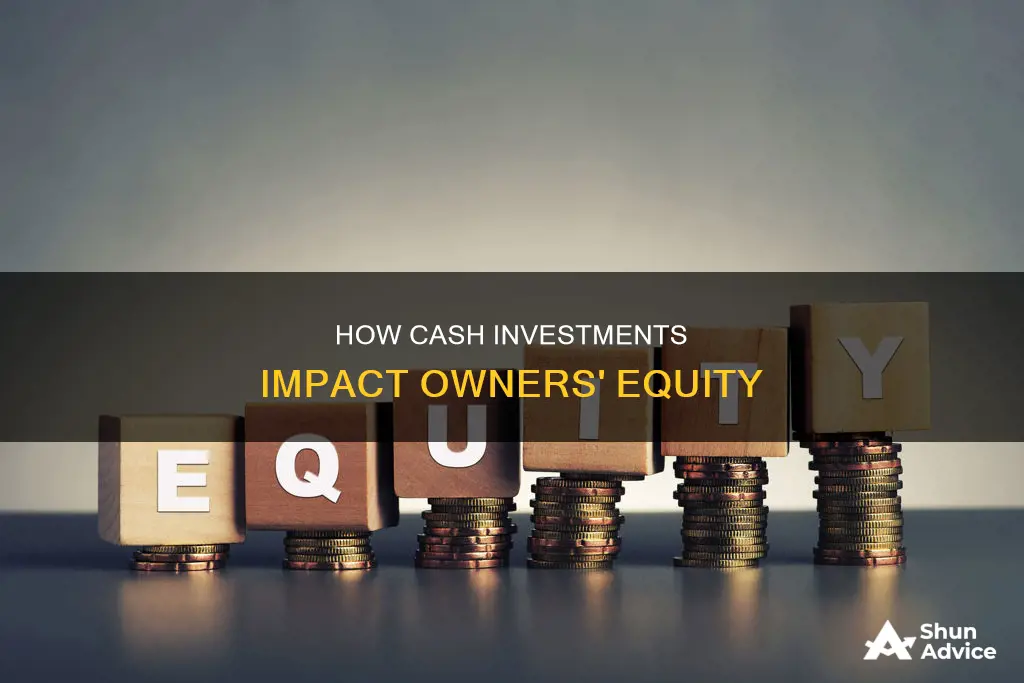
Owners' equity is an important measure for business owners to understand the value of their stake in the business. It is the amount of ownership in the business after subtracting liabilities from assets. Liabilities must be paid off first, so they take priority over owners' equity. Owners' equity is calculated as the total value of a company's assets minus the company's liabilities. A company with higher assets than liabilities will show positive owners' equity.
Owners' equity increases when an owner increases their investment in the business or when the company increases its profits. Owners' equity decreases when the owner withdraws money from the business or when the business makes a loss.
What You'll Learn

Owner's equity increases with higher profits
Owners' equity is a crucial metric for understanding the financial health of a company and evaluating its performance over time. It is calculated by subtracting a company's liabilities from its assets, providing insight into the ownership interest in the business. When a company increases its profits, the owners' equity also increases. This positive correlation between profits and owners' equity is a key aspect of financial management.
Owners' equity, also known as net worth, reflects the value of a company's assets that the owner(s) can claim as their own. As profits rise, the company's overall value increases, leading to a higher owners' equity. This increase in equity signifies a healthy and growing company. Conversely, if liabilities exceed assets, negative owners' equity arises, indicating potential financial troubles.
The impact of profits on owners' equity is particularly evident in the context of retained earnings. Retained earnings are the profits reinvested into the business rather than distributed as dividends. As a company generates higher profits, its retained earnings grow, contributing to a rise in owners' equity. This increase in equity, in turn, enhances the company's financial stability and ability to pursue growth opportunities.
Additionally, higher profits can enable companies to reduce their liabilities, further bolstering owners' equity. By utilising profits to pay off debts, refinance high-interest loans, or lower operating expenses, companies can decrease their liabilities and, consequently, increase owners' equity. This strategic approach to financial management strengthens the company's overall financial position.
Moreover, the relationship between profits and owners' equity extends beyond privately owned businesses. In publicly traded companies, where owners' equity is referred to as shareholders' equity, profits still play a pivotal role in equity growth. As a company's profits increase, its shareholders' equity rises, benefiting the shareholders who have a claim in the business.
In summary, the link between owners' equity and profits is fundamental in business finance. Increasing profits contribute directly to higher owners' equity, indicating a company's financial health and growth potential. This relationship underscores the importance of effective financial management and strategic decision-making to maximise owners' equity and drive long-term success.
Cash App Investing: Are There Any Fees Involved?
You may want to see also

Owner's equity increases with higher capital contributions
Owners' equity is the amount of ownership a business owner has in their business after subtracting their liabilities from their assets. It is also referred to as net worth, equity, or net assets. This calculation is important because it helps owners understand the value of their stake in their business and evaluate their finances.
Owners' equity increases with higher capital contributions. This can take the form of cash or other assets, such as equipment or vehicles. When an owner makes an investment in the business, the company's assets increase, and so does the owner's equity. This is reflected in the accounting equation: Assets = Liabilities + Owner's Capital + Revenues – Expenses – Draws.
In addition to capital contributions, owners' equity can also increase through higher profits. This can be achieved through increased sales or decreased expenses. However, if an owner takes money out of their equity, it is considered a capital gain, and they will have to pay capital gains tax on the withdrawn amount.
It is important to note that owners' equity is different from shareholders' equity, which applies to widely held public businesses. In the case of a sole proprietorship or partnership, the value of equity is indicated as the owner's or partners' capital account on the balance sheet.
Fidelity's Cash Policy: What Investors Need to Know
You may want to see also

Owner's equity decreases with money withdrawals
Owners' equity is the amount of ownership one has in their business after subtracting their liabilities from their assets. Liabilities, such as loans, accounts payable, and mortgages, are debts that a business owes. Assets, on the other hand, are anything the business owns, such as cash, cars, and intellectual property.
Owners' equity is important as it helps owners understand the value of their stake in their business. It is also a valuable indicator of a business's financial health and can help track whether the company is gaining or losing value over time.
Owners' equity decreases when the owner makes withdrawals from the business. This is because withdrawals are considered capital gains, and the owner must pay capital gains tax depending on the amount withdrawn. The amount withdrawn is subtracted from the owner's capital on the balance sheet to obtain the equity total.
For example, if an owner withdraws $1,000 from the company for personal use, a debit of $1,000 is entered as an "Owner Withdraw" or "Owner Draw" on the balance sheet, and a credit of $1,000 is entered to "Cash." This withdrawal is then subtracted from the owner's capital to obtain the equity total. At the end of the fiscal year, the draw account is closed, and the withdrawal amount is transferred to the owner's capital account, reflecting a reduction in the amount of capital retained in the business.
If owners withdraw too much money, it can push a business's equity into negative territory, indicating that the company has more liabilities than assets. Negative equity can create long-term problems for a business as it may struggle to pay its liabilities. Therefore, while owners' withdrawals do decrease owners' equity, it is important to consider the overall financial health of the business and ensure that withdrawals do not exceed the business's ability to sustain them.
Operating vs Investing: Where Do Customers Fit in Cash Flow?
You may want to see also

Owner's equity decreases with losses
Owners' equity, also referred to as net worth, equity, or net assets, is the amount of ownership one has in their business after subtracting their liabilities from their assets. This calculation is important because it helps evaluate one's finances and determine how much capital is available for activities like investing.
Owners' equity will decrease if there are expenses and losses. Losses reduce the net income of the business, which in turn decreases the owner's equity. When a business is not making a profit, the owner's claim on the business's assets is reduced because there is less wealth generated by the business. For example, if a business incurs a loss of $5,000 in a month, the owner's equity decreases by $5,000, meaning the owner's net worth in the business is lower.
If liabilities become greater than assets, negative owners' equity will result. Negative equity can be reversed by securing more investments or increasing profits.
Positive Cash Flows: A Smart Investment Strategy?
You may want to see also

Owner's equity is calculated by subtracting liabilities from assets
Owners' equity is calculated by subtracting liabilities from assets. This calculation is a key variable in the classic accounting equation: Assets = Liabilities + Owners' Equity.
Liabilities must be subtracted first because, in the case of a sale or liquidation, those must be paid before the owner can collect any remaining funds. Owners' equity is listed on a company's balance sheet and can be positive or negative. A negative owners' equity occurs when the value of liabilities exceeds the value of assets.
Owners' Equity = Assets – Liabilities
Let's say your business has assets worth $50,000 and you have liabilities worth $10,000. Using the owners' equity formula, the owners' equity would be $40,000 ($50,000 – $10,000).
Another example would be if your business owned land that you paid $30,000 for, equipment totalling $25,000, and cash equalling $10,000. Your total assets would be $65,000. You owe $10,000 to the bank and you owe $5,000 in credit card debt. Your total liabilities would be $15,000. Your owners' equity would be $50,000 ($65,000 – $15,000).
Owners' equity is an important measure to help owners understand the value of their stake in their business. It is often considered to be the company's "net worth". Owners' equity is also a valuable indication of a business's financial health and a way to track whether the company is gaining or losing value over time.
Understanding Invested Assets: Does Cash Count?
You may want to see also







